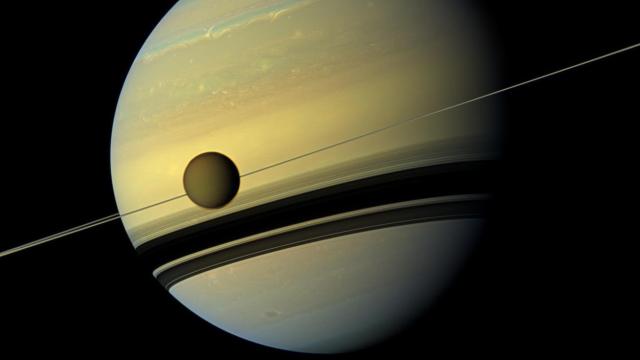Titan is migrating away from its host planet at a rate 100 times faster than the previous estimate. The discovery is shaking our understanding of Saturn and the origin of its natural satellites.
Titan, the only moon in our solar system with an atmosphere, is pulling away from Saturn at a rate of 11 centimetres per year, according to new research published this week in Nature. The previous estimate was 0.1 cm per year, which is 100 times slower than the new estimate.
Such a tiny migration rate may seem trivial in the hugeness of space, but like our slowly shifting continents, these tiny steps add up over vast time scales. For Titan, this means a wholesale rethinking of its astrophysical history and likely of the entire Saturnian system itself. What’s more, the updated estimate is validating a recently proposed theory having to do with this exact phenomenon: the outward migration of planetary moons.
Moons with sufficient mass exert a small gravitational tug on their host planets, causing a temporary bulge. These incessant ebbs and flows distort the planet’s gravitational field, causing the moon to be pushed forward along its orbit and away from its host. Such is the case right here, as our Moon slowly drifts away from Earth at a rate of 3.8 cm per year. But don’t panic; we’re not at risk of losing our Moon to the depths of space, as the Moon’s rate of escape is so slow that our Sun will destroy both Earth and the Moon before that could happen.
The new estimate was made possible by analysing data collected by NASA’s Cassini spacecraft, which spent 13 years exploring Saturn prior to its heroic death dive in 2017. In a method known as astrometry, scientists mapped stars in the background of Cassini images to establish a static frame of reference. This allowed them to accurately track Cassini’s position over time, including its proximity to Titan. The other technique, called radiometry, measured the spacecraft’s speed as it was influenced by Titan’s gravitational pull. Using data from these two independent techniques, the researchers came up with the same estimate for Titan’s rate of outward drift.
The new estimate is raising important questions about Saturn and when its natural satellites first formed. Saturn popped into existence some 4.6 billion years ago, during the very early stages of our solar system’s development, but less is known about the origin of its iconic rings and many moons, of which there are over 80.
Titan is currently 1.2 million kilometers from Saturn, but when applying the new rate of drift, this means the moon began its life in close proximity to the gas giant. The entire Saturnian system must have expanded more rapidly than what is conventionally believed, according to these findings.
“This result brings an important new piece of the puzzle for the highly debated question of the age of the Saturn system and how its moons formed,” explained Valery Lainey, the lead author of the study, in a NASA press release. Lainey now works at the Paris Observatory at PSL University, but he conducted this research while at NASA’s Jet Propulsion Lab in southern California.
The new paper also validates a theory proposed four years ago by theoretical physicist Jim Fuller, a co-author of the new paper and an astrophysicist at Caltech. Unlike conventional theories, which assume a slow rate of drift for outer moons owing to the lower influence of gravity, Fuller’s theory suggests that the outer moons might be locked in a special orbital pattern, as explained in the Caltech press release:
His theory notes that Titan is expected to gravitationally squeeze Saturn with a particular frequency that makes the planet oscillate strongly, similarly to how swinging your legs on a swing with the right timing can drive you higher and higher. This process of tidal forcing is called resonance locking. Fuller proposed that the high amplitude of Saturn’s oscillation would dissipate a lot of energy, which in turn would cause Titan to migrate outward away from the planet at a faster rate than previously thought.
The new calculations are very much in concert with this idea, as Fuller’s models are in full agreement with the calculations made with Cassini data. Excitingly, Fuller’s model could apply to different types of astrophysical contexts, including binary star systems and exoplanet systems.
[referenced url=”https://gizmodo.com.au/2020/06/more-evidence-that-mars-once-had-a-ring-and-will-again/” thumb=”https://gizmodo.com.au/wp-content/uploads/2020/06/04/hp8xcw91qkw42irfsjtd-300×169.jpg” title=”More Evidence That Mars Once Had a Ring and Will Again” excerpt=”New research offers an explanation for the unusual orbit of Mars’ moon Deimos, one that bolsters the hypothesis that the Red Planet periodically features a Saturn-like ring.”]
A very different kind of moon made the news last week, as scientists found further evidence that Phobos, a small Martian moon, is caught in a cycle of death and rebirth, which occasionally results in a ring around the Red Planet.
